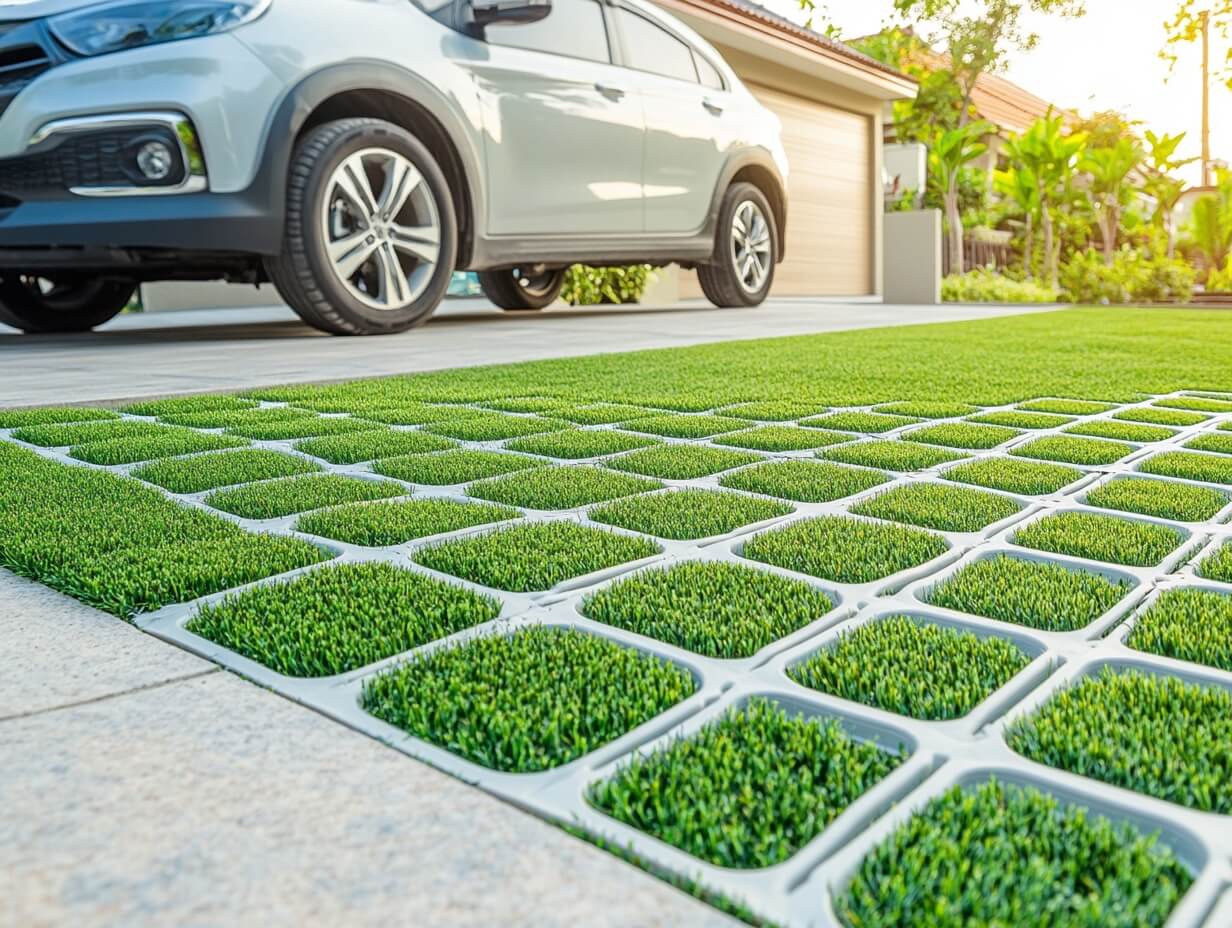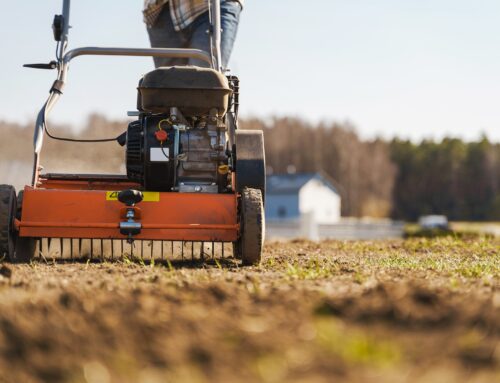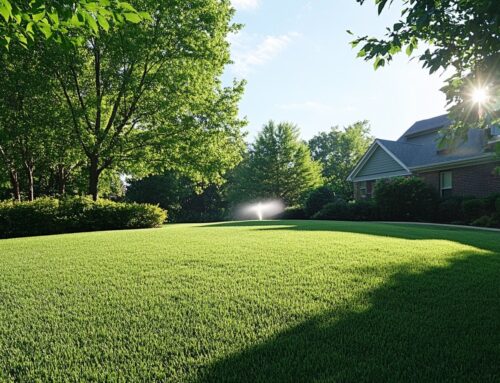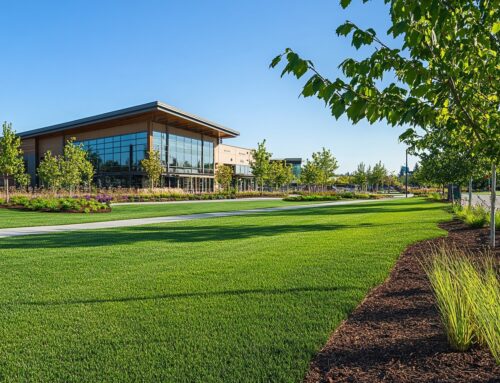Table of Contents
Introduction
Excessive water buildup from snowmelt and spring rains often results in flooding and soil erosion. Impermeable surfaces such as asphalt and concrete make the situation worse by preventing natural water absorption in urban and suburban areas. Reinforced grass driveways help to alleviate this issue by allowing water to filter through the surface naturally. Sustainable drainage solutions such as these permeable driveways are a practical and environmentally responsible part of flood prevention landscaping.
What Are Reinforced Grass Driveways?
Reinforced grass driveways consist of a structured grid system, typically made from concrete or durable plastic. This is laid over a compacted base and filled with grass seed and soil, allowing for the growth of grass and giving the appearance of a traditional lawn, while providing support for the weight of a vehicle.
Unlike asphalt and concrete, these permeable driveways allow water to seep directly into the ground, reducing the strain on stormwater systems and mitigating the risk of flooding. Reinforced grass driveways also help to counter the urban heat island effect and require fewer raw materials than conventional paving, making them a sustainable option. While they require maintenance such as occasional receding and grid stabilization, they offer a longer lifespan with minimal environmental impact.
The Benefits of Permeable Grass Driveways
Permeable grass driveways Are an excellent choice for flood prevention landscaping, offering several benefits such as:
Soil and Erosion Protection
One of the primary advantages of reinforced grass driveways is the effective management of excess water. Asphalt driveways channel water into storm drains, while this sustainable drainage solution allows for the absorption of precipitation, replenishing groundwater and minimizing localized flooding.
Eco-Friendly and Sustainable Landscaping
Traditional driveways contribute to heat build-up, reducing air quality and increasing energy consumption. Reinforced grass driveways help to lower surface temperatures, promote oxygen production, and help to trap and store carbon dioxide.
Aesthetic and Functional Advantages
Reinforced grass driveways blend seamlessly with lawns and gardens, providing a natural aesthetic pleasing to many homeowners. Additionally, they provide a sturdy surface to support vehicles without sacrificing green space.
Installing a Reinforced Grass Driveway
Before initiating a grass driveway installation, there are a number of factors to consider including soil composition, slope, and drainage. Choosing the right type of reinforcement grid provides greater durability, while a level surface with proper grading allows for more effective water absorption.
Step-by-Step Installation Guide
Proper installation of your reinforced grass driveway should involve the following steps:
Prepare the Base
Clear any existing material from the installation site and compact the subsoil.
Install a Gravel Foundation
The installation of a gravel foundation improves drainage and prevents waterlogging.
Place a Reinforcement Grid
Ensure that the grid is securely fitted and evenly distributed for proper support.
Fill with Soil and Grass Seed
Once securely in place, the grid should be filled with soil and grass seed, allowing for even coverage.
Water and Maintain
Regular watering will encourage healthy grass growth for a more aesthetically pleasing appearance.
Timeframe and Cost Factors
Grass driveway installation takes one to two weeks on average, although this depends on weather conditions and grass establishment. Costs will vary, though reinforced grass driveways are typically more affordable than concrete and asphalt options when long-term maintenance and environmental benefits are taken into account.
Maintenance Tips for Long-Term Performance
Although reinforced grass driveways are durable, they require occasional maintenance, including:
Regular Watering and Grass Care
Proper hydration is required for strong grass growth, which aids in water filtration. Increased watering during dry spells, fertilization in spring, and other seasonal adjustments will keep the grass healthy.
Weed Control and Grid Stability
Natural herbicides or manual removal will help prevent weed overgrowth. Checking periodically for grid displacement is important for long-term driveway stability.
Winter Maintenance Considerations
Plastic shovels and snow blowers can be used to remove snow period to prevent ice formation, sand or calcium magnesium acetate are appropriate rock salt alternatives that will not harm the grass.
Comparing Reinforced Grass Driveways to Other Permeable Solutions
Reinforced grass driveways are not the only permeable alternative to traditional driveways.
Although permeable pavers offer structural support, they lack the natural benefits of grass, making them less ideal for those seeking an eco-friendly solution. In addition, many homeowners find reinforced grass driveways more aesthetically pleasing.
Gravel Driveways vs. Grass Driveways
Gravel driveways provide drainage, but can scatter over time, requiring frequent replenishment. Reinforced grass driveways offer superior soil retention and a more natural appearance.
Bioswales and Rain Gardens as Complementary Features
To make your reinforced grass driveway more efficient, consider pairing it with bioswales and rain gardens. These help manage runoff for enhanced flood prevention while increasing water absorption in surrounding areas.
Looking for a flood-resistant driveway solution? Contact us today to explore reinforced grass driveway options tailored to your property!
Conclusion
Looking for a flood-resistant driveway solution? Contact us today to explore reinforced grass driveway options tailored to your property. Explore our sod installation services, learn about sod site preparation, or contact us now for expert guidance.






